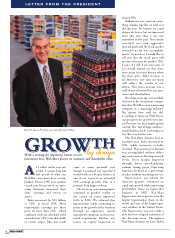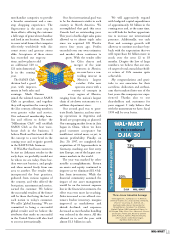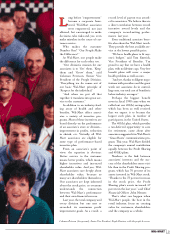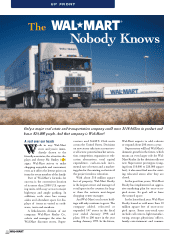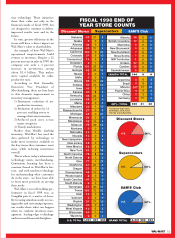Walmart 1998 Annual Report Download - page 13
Download and view the complete annual report
Please find page 13 of the 1998 Walmart annual report below. You can navigate through the pages in the report by either clicking on the pages listed below, or by using the keyword search tool below to find specific information within the annual report.
Officer of Wal-Mart Stores, Inc.
The investment community sat
up and took notice. Analyst after
analyst has given Wal-Mart ratings
of “buy” (Credit Suisse First
Boston Corp. and Genesis
Merchant Group) or “strong buy”
(Salomon Brothers).
No doubt the largest single
Wal-Mart investor in fiscal
1998 was Wal-Mart
itself. In a move to
improve shareholder
value, the Board of
Directors autho-
rized a $2 billion
share repurchase
program. In March
1998, management
expanded the share repur-
chase program to the level of $2
billion over the next 12 to 18
months.
“Our share repurchase program
really sends a message of confi-
dence in the company to Wall
Street,” said Executive Vice
President and Chief Financial
Officer John Menzer, “and it was a
great investment for us, too. We
started buying in the low 20s, and
the stock ended up rising 73 percent
in the last calendar year. Wal-Mart
had the second-highest return to
shareholders among the 30 blue-
chip stocks that make up the Dow
Jones Industrial Average.”
Wal-Mart shareholders also saw
an immediate increase in their
returns in fiscal 1998 when the div-
idend was increased by 29 percent.
Combine those actions with
Wal-Mart’s ongoing drive to do
business better, increasing profits
while managing our capital, and
management believes the company
is on track to achieve its goal of 15
percent total annual shareholder
returns. Analysts agree.
“Wal-Mart’s improved execu-
tion is more than simply a focus on
improving the return on invest-
ment,” Analyst Michael Exstein of
Credit Suisse First Boston wrote in
late 1997. “Instead, a number of ini-
tiatives, including merchandising
and operational changes and more
disciplined financial management,
have combined to produce
improved results.”
By concentrating on the basics
of its business, Wal-Mart continues
to build shareholder value.
Wal-Mart’s growth, in the future
as well as the past, is based ona tight
focus on the Wal-Mart equation:
“People + Product + Price =
VALUE!”
H. Lee Scott Jr.,
President and CEO of
the Wal-Mart Stores
Division, identified
four key legacies of
Wal-Mart Founder
Sam Walton that contin-
ue to guide the company’s
quest for ever-greater value:
1) Every Day Low Prices (EDLP)
2) Customer Service
3) Leadership
4) Change
“We have never been afraid of
change,” Scott said, noting that
Mr. Sam was always willing to take
risks for the sake of change.
“At Wal-Mart, we are always
challenging ourselves to continue
to improve, because we can’t allow
ourselves to become complacent,”
Scott said. “We have not yet
arrived at the level we are always
striving to achieve.”
Wal-Mart’s dedication to value -
for our customers, our associates
and our shareholders - has pro-
duced what Don Soderquist, Vice
Chairman and Chief Operating
Officer, calls “the most incredible
story ever told in American
business.”
When Wal-Mart first went pub-
lic, in October 1970, a foresighted
investor could have bought 100
shares of the stock for $1,650.
Today, that investor’s 100 shares
would have grown to 102,400
shares, worth more than $5.1 mil-
lion at Wal-Mart’s recent closing
price of 50, for an average gain of
more than $180,000 per year. In
addition, that holding would have
paid $27,000 in dividends in 1997.
“This is a long-term game,” Glass
said. “We don’t have any short-
term plans at Wal-Mart.
Everything we do is designed to
build shareholder value over the
long haul. Our opportunities are
unparalleled in the history of retail-
ing because of where we are now,
and the capability and determina-
tion we have to keep getting
better.”
13
Sales (in billions)
92 93 94 95 96 97
120
100
80
60
40
20
0
$44
$83
$94
$105
$56
$67
Fiscal year
$118
98
$160
140



